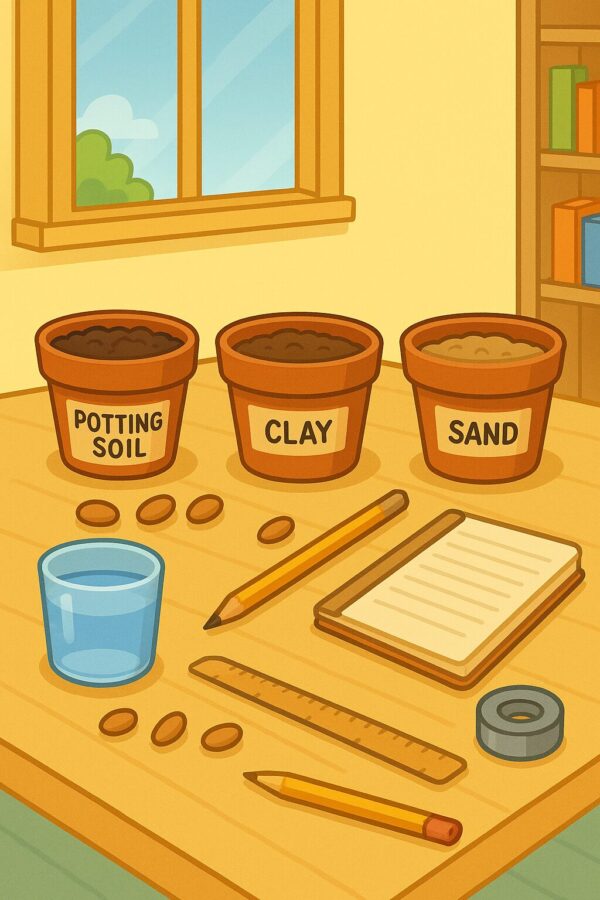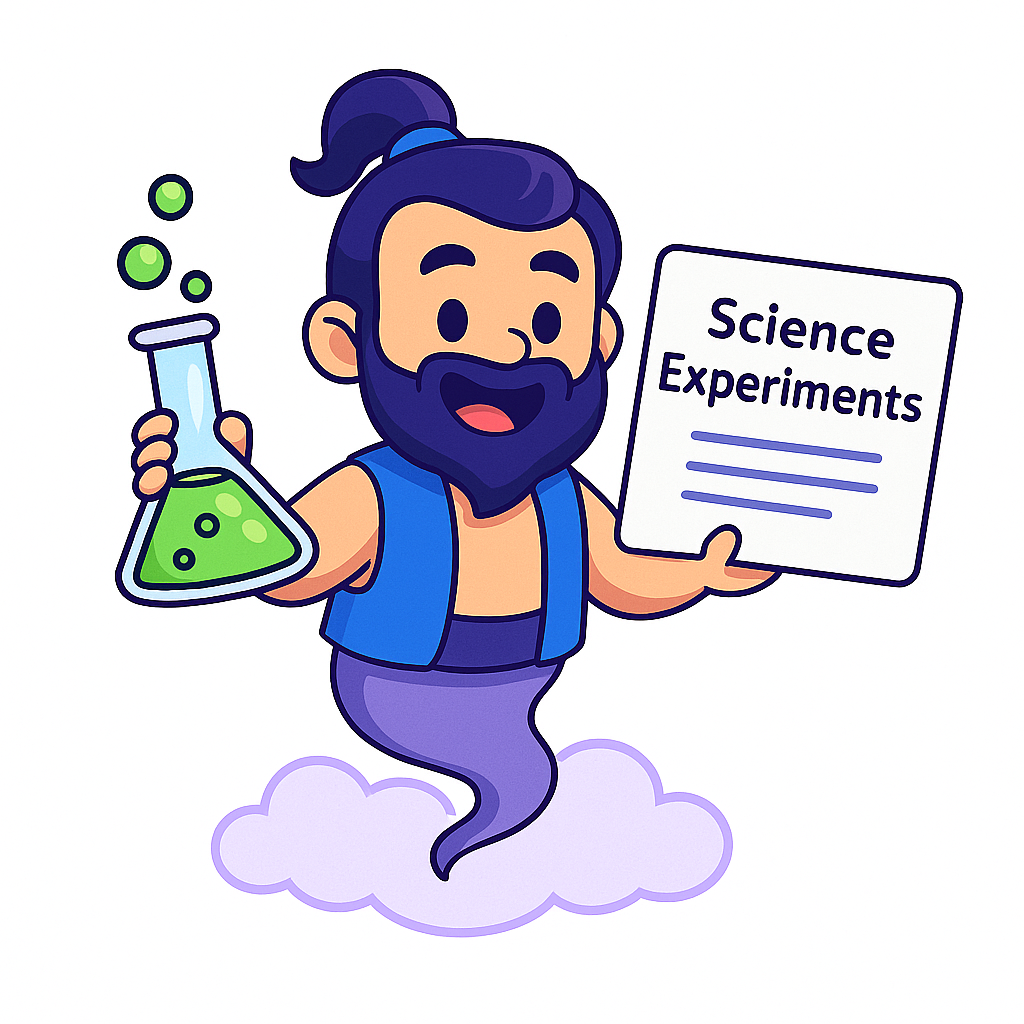 How Different Soils Affect Plant Growth:
How Different Soils Affect Plant Growth:
A Hands-On Science Experiment for Kids
A Hands-On Science Experiment for Kids
Did you know the dirt in your backyard could make or break a plant’s growth? This hands-on experiment reveals how different soil types—potting soil, clay, and sand—affect plant health, height, and development. Perfect for 6th–8th grade (but fun for all ages), this project guides parents and homeschoolers step-by-step to set up a true science fair–worthy test of soil quality and its effects on living things.
You’ll get background science, parent teaching tips, observation and data ideas, and connections to real-world agriculture and gardening. By the end, you’ll understand why healthy soil matters for everything from backyard flowers to global food crops!
Experiment Details
- Grade Level: 6th–8th Grade (adaptable for elementary through high school)
- Key Topics: Soil Science, Plant Growth, Scientific Method, Variables
- Estimated Time: 1 hour setup, 3 weeks observation
- Mess Factor: Low to medium (soil and water spills possible)
Purpose: To discover how different types of soil—potting soil, clay, and sand—affect the way a common plant grows.
Hypothesis: If plants are grown in different soil types, then the plants in soil with better nutrients and drainage will grow taller and healthier than those in poorer soil.
What You’ll Need
- 3 small pots or containers (about 6″ wide and 6″ tall each)
- Potting soil (available at garden centers or hardware stores)
- Clay soil or local garden dirt (can be collected from outside or purchased)
- Sand (play sand or coarse sand from hardware store)
- 3 bean seeds or other fast-growing seeds (like radish or sunflower)
- Water (about 1 cup, plus more for ongoing watering)
- Ruler (to measure plant height in inches or centimeters)
- Notebook and pencil for recording data
- Labels or tape to mark each pot (“Potting Soil”, “Clay”, “Sand”)

Step-by-Step Instructions
- Label each pot clearly with the soil type: “Potting Soil,” “Clay Soil,” and “Sand.”
- Fill each pot about 4 inches deep with its respective soil. Try to keep soil level the same in all pots.
- Plant one seed about 1 inch deep in each pot. Cover gently with soil.
- Water each pot with 1/4 cup of water, making sure soil is moist but not soggy.
- Place all pots in a sunny location (inside on a windowsill or outside) where they’ll get the same amount of sunlight.
- Water the plants every two days with the same amount of water (about 1/4 cup).
- Measure the height of each plant every 3 days using a ruler. Record the measurements and observations in your notebook (plant height, leaf color, number of leaves, etc.).
- Continue for 3 weeks or until you see clear differences in growth.
- At the end, compare the average height, health, and appearance of the plants in each soil type. Which grew tallest? Which had the healthiest leaves?

Soil Science: Why Does Soil Matter for Plants?
Soil isn’t just “dirt”—it’s a complex mixture of minerals, organic matter, water, air, and living organisms. The quality and type of soil can make a huge difference for how plants grow. Healthy soil provides:
- Nutrients: Plants absorb essential minerals from soil, such as nitrogen, phosphorus, and potassium.
- Water retention: Good soil holds enough water for plants to use, but also drains so roots don’t drown.
- Air spaces: Roots need oxygen! Dense or waterlogged soil can suffocate roots.
- Support: Soil anchors plant roots and provides a stable place to grow.
Comparing Soil Types
- Potting soil is specially designed for plant growth, with a blend of peat moss, compost, perlite, and nutrients. It’s light, holds moisture well, and provides plenty of air pockets for roots.
- Clay soil tends to be heavy and dense. It holds water tightly (sometimes too much), can be slow to drain, and may limit air flow to roots. Some nutrients are present, but the density can make it hard for roots to grow and “breathe.”
- Sandy soil is loose and drains quickly. It has big particles and lots of air spaces—but it doesn’t hold water or nutrients well, so plants may dry out or miss out on minerals.
Why Test Soils?
Farmers, gardeners, and scientists test soil to see what plants will grow best in different places. The same plant can thrive in one soil but struggle in another. Understanding soil science is crucial for growing food, restoring habitats, and protecting the environment.
Plant Science: Roots, Leaves, and Growth
When a seed sprouts, roots grow downward to search for water and nutrients, while shoots grow upward to find light. Roots need soil that lets them spread out and absorb what they need. If soil is too dense (like clay), roots struggle. If soil is too loose (like sand), roots may not get enough water or nutrients. Potting soil strikes a balance for most garden plants.
What’s Happening in This Experiment?
- Plants in potting soil will usually grow taller, with greener leaves and stronger stems.
- Plants in clay soil may show slower or stunted growth, with pale or curled leaves due to lack of air or root space.
- Plants in sandy soil may struggle to sprout or show wilting/yellow leaves due to dryness and low nutrients.
The experiment teaches kids (and parents!) how important it is to keep water, sunlight, and all variables the same—so that soil is the only thing changing. That’s good science!
Learning Objectives
- Understand the role of soil in providing water, nutrients, and support for plants
- Observe and compare plant growth in different soil types
- Practice making and testing a hypothesis using a controlled experiment
- Learn to measure, record, and analyze scientific data over several weeks
- Develop skills in observation, graphing, and drawing scientific conclusions
Teaching & Parent Tips
- Keep all environmental factors the same—sunlight, water, seed type, and pot size. Only the soil should change.
- Encourage your child to take clear, dated photos as the plants grow. Use these photos as part of a science notebook or presentation.
- Discuss why it’s important to control variables and only change one thing at a time in a science experiment.
- Let your child make daily or every-other-day sketches of each plant to supplement measurements.
- Talk about the results in the context of gardening, farming, and food security—why does soil health matter in the real world?
- If possible, show your child examples of garden soil, clay, and sand in your area for a real-world tie-in.
Standards Alignment
NGSS MS-LS1-5: Conduct an investigation to provide evidence that plants need water and sunlight to grow.
Common Core ELA-Literacy.RST.6-8.3: Follow precisely a multistep procedure when carrying out experiments.
Printable Worksheet
Want a ready-to-use printable version for your class or homeschool?

Frequently Asked Questions
You can use fast-growing seeds like radish, sunflower, or grass. For more advanced projects, try flowers or vegetables, and compare which ones are more sensitive to soil type.
Yes! You can add used soil to your garden or compost. Just be sure to mix and enrich it with organic matter for best results.
Sandy soil doesn’t hold enough water or nutrients; clay may be too dense for roots to get air and expand. That’s why gardeners often mix different soils for the best results!
Farmers and gardeners add compost, manure, mulch, and other amendments to boost nutrients, improve texture, and help soil hold just the right amount of water.
Related Experiments
- How Light Color Impacts Plant Growth
- The Water Cycle in a Bag
- Homemade Compass
- See All Science Experiments & Generator
Share Your Results!
Did you try this experiment? Share your photos, results, or questions below!
⭐ What Parents & Teachers Are Saying
Recent Feedback
There are no reviews yet. Be the first one to write one.
